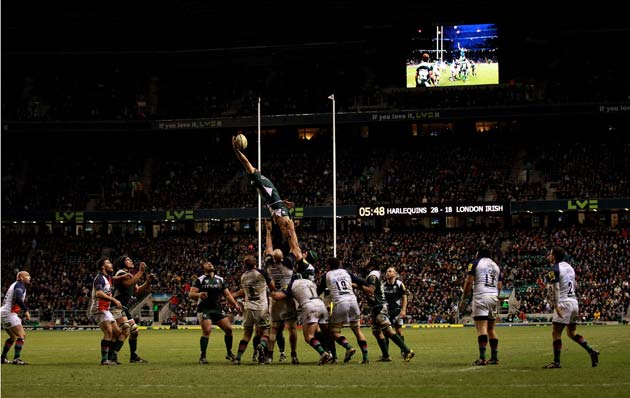Peter Bills: Harlequins attendance shows health of rugby
Talking Rugby

If ever the enormous potential of this game were emphatically underlined, then a single attendance at a solitary game confirmed it over the festive season.
From attracting crowds of around 12,000 to most of their home games, the Harlequins club switched its December 27 club match against London Irish to Twickenham. What could they expect in response?
Well, it was Christmas and a lot of people were still on holiday, doubtless keen to get out and get some fresh air. And rugby matches over Christmas have a long history in this part of the world.
As a youngster, I can remember stuffing down the last mouthfuls of Boxing Day lunch and, coat and gloves on, hurrying across Blackheath to the famous old Rectory Field. There, every year, Blackheath played a Boxing Day fixture against the famous French side, Racing Club de France.
Mind you, on those days, public transport ran on Boxing Day. And there was always a very healthy crowd to see ‘ze frogs’.
But not as healthy as the crowd Harlequins lured to headquarters this Christmas. I bet they would have been happy if they’d been guaranteed a 35-40,000 attendance figure, when they started selling tickets.
Yet an astonishing 74,212 turned up, just a few thousand short of the ground’s enormous capacity. True, the rugby wasn’t much cop, as one disgruntled punter complained last week, moaning about the inordinate number of re-set scrums. He also suggested removing the No. 8 from teams so as to create a bit more space on the field.
That’s a discussion for another day. But what is undeniable is the interest and support that clearly exists in this part of the world for these special ‘one off’ matches on unique occasions. And it isn’t just in London. Max Guazzini has pioneered the idea of playing the occasional Stade Francais club match at the 80,000 Stade de France so successfully that he’s regularly sold around 75-79,000 tickets.
Mind you, Guazzini’s ‘spectaculars’ involving fake Roman chariots, scantily clad guards and girls, rock music shows and brilliant firework displays guarantee that numerous families turn up.
But this is the glory of this game. It should be bursting out of its skin, thrusting forward to embrace new audiences, new groups of followers. And if the product on the field is improving – witness matches like England v Australia last November at Twickenham and South Africa v Australia in Bloemfontein in last year’s Tri-Nations - there is no reason on earth why the game wouldn’t grow.
But one thing worries me about this process. In too many instances, officialdom continues to drag heavily behind this eager, burgeoning sport which wants to embrace the future in so many exciting ways.
Too many of those at the top plod cautiously forward, as they always have done. Not, it should be said, in every case. The news that the IRB have abandoned the system of ‘Buggin’s turn’ when it comes to choosing referees for major internationals is to be heartily welcomed.
They have concluded that the five best referees in the world should get more and more games. A second group of five will get some games at the World Cup this year, but not the top matches. That is exactly how it should be.
Sadly, other rugby officials lag far behind such modern day thinking. Take ERC, the body that runs the Heineken Cup. They even ban freedom of speech, a basic human right, by fining the Saracens Director of Rugby Brendan Venter 25,000 euros, albeit 15,000 suspended pending what they regard as ‘better behaviour’ in future, for honestly expressing his concerns about the standard of refereeing in a Heineken Cup game.
Yet Venter’s Leicester counterpart Richard Cockerill completely escaped sanction when he too criticised referees, arguably in stronger terms than Venter.
Where is the consistency in this and, more importantly, where is the vision and true leadership?
Disappointingly, ERC always go for the safe option when it comes to selecting a venue for the climax of their flagship event, the Heineken Cup final. Murrayfield, Cardiff, Twickenham, Paris or Dublin – the final, it seems, cannot be played anywhere else. Thus, it is like a wheel slowly turning so that, this year, we’re back to Cardiff. How predictable, how boring.
Of the 16 Heineken Cup finals that will have been staged come this May, a staggering SIX will have been in Cardiff. I mean, do ERC have shares in the Millenium Stadium, or something?
There have been three finals at Twickenham, and two each at Murrayfield, Dublin and Paris. One was held in Bordeaux.
But where is the innovation, the forward thinking in keep going back to Cardiff? Why not make it a spectacular rugby weekend for all of Europe and Britain by taking it to the Camp Nou in Barcelona, or the San Siro, Milan? Both would be superb venues, as the All Blacks showed by drawing 80,000 to the San Siro for a Test against Italy in 2009. Graham Henry called it one of the greatest experiences of his life.
Then there’s the Velodrome in Marseille, the Olympic Stadium in Rome or the Stadio del Alpi in Turin.
But no, it always has to be at the tried and tested, which usually means Cardiff.
It is this lack of imagination, this absence of forward thinking and innovation which is holding back the development of a fantastic sport.
Join our commenting forum
Join thought-provoking conversations, follow other Independent readers and see their replies
Comments